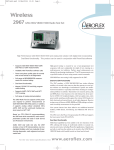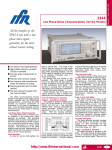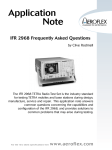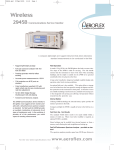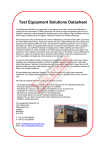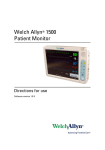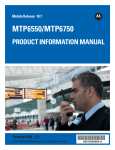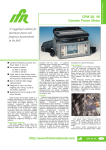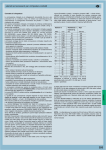Download IFR - 2968
Transcript
Wireless 2968 TETRA Radio Test Set The 2968 TETRA Radio Test Set for comprehensive terminal and base station testing • TETRA terminal and base station test options • Trunked Mode and optional Direct Mode control a TETRA radio and then make measurements of key transmitter and receiver RF and audio parameters. Measurements are performed accurately with speed and ease. • Simplex and Duplex operation TETRA Measurements • Group, Individual, Phone and Emergency call types • Direct or Hook signalling • TIPv3 compliant • ETSI EN 300 394-1 transmitter and receiver measurements • TETRA Test (TT) registration and TT loopback BER testing • TI test signal generation and T1 loopback and BER testing • Auto-test mode for fast terminal testing • Audio loopback testing for voice or tones • Multi-standard platform • Optional TETRALOG protocol analysis • Full span spectrum analyzer and tracking generator • Audio FFT analysis The IFR 2968 TETRA Radio Test Set is a single box solution for testing TETRA radio terminals and / or base stations and has been designed to offer maximum flexibility to satisfy applications in design, manufacturing and radio maintenance. The test set provides all the necessary signalling to Transmitter measurements performed on terminals and base stations include burst power, power profile, frame alignment (burst timing error), frequency error, modulation accuracy (EVM) and residual carrier. All are performed in accordance with ETSI EN 300 394-1. These parameters are measured for each of the different TETRA burst types and displayed numerically on a summary screen as well as a graphical bar chart. Individual parameters are supported by dedicated graphical displays to aid design engineering or fault diagnosis. Demodulated symbol data for captured bursts can be displayed or output for offline storage or analysis. The IFR 2968 is able to perform TETRA receiver sensitivity measurements by various means depending upon the capability of the radio under test. TETRA terminals supporting TT loopback can be automatically tested by allowing the 2968 to control test mode registration and RF loopback during which BER, MER and RBER parameters can be measured. Terminals supporting T1 test mode can be tested for BER using T1 loopback; MER and BER may be measured by the terminal under test using the T1 signals generated by the 2968. The T1 signal types supported include TCH/7.2 type 1, TCH/2.4 type 4 and SCH/F type 2. Receiver sensitivity (SINAD, Distortion) may also be tested by recovering and analyzing audio signals from the terminal using the array of standard audio analysis features of the tester. The 2968 provides the necessary RF stimulus modulated with a digitized encoded audio tone, silence or 'talkback'. For base station testing the 2968 supports synchronization either to the downlink signal generated by the base station or to a synchronization pulse output from the base station. The RF T1 Test signal For the very latest specifications visit www.aeroflex.com generated in the test set (TCH/7.2 type 7) stimulates the base station receiver to enable internal BER measurement. Network Simulation The IFR 2968 is highly configurable to enable it to emulate a wide variety of different TETRA networks, such that a terminal under test recognizes the IFR 2968 as the network for which it is configured. Functional tests provide an essential check for terminals before they are deployed into a TETRA network or when returning to active service after repair. • The various TETRA RF channel plans are all supported together with user defined or NO PLAN options making the 2968 suitable for use wherever TETRA systems are deployed. • TX slot selection and RF power control modes are made user definable to improve versatility. • Group attachment, detachment and modification functions are supported for up to 40 different groups. Displayed GSSI information makes it simple for users to verify that terminals are correctly configured for the target user. • SDS-TL text messages (up to 120 characters) can be sent or received by the test set using either TETRA or GSM message coding schemes. Sent messages can be time stamped and received messages can be displayed with destination SSI and ESN. When requested the tester provides a message received response to the terminal. Call Processing Functions The 2968 supports all the necessary call processing functions required for terminal testing. These include registration, de-registration to / from a network, mobile originated and mobile terminated call set-up and clear down. Supported call types include individual, group, telephone, emergency and user defined. An audio loopback (talk-back) feature is provided to enable simple end to end testing. In talkback received audio from the terminal microphone is received, time delayed, then re-transmitted to the terminal from the 2968 and output from the terminal loudspeaker. Auto-test Pre-defined auto-test sequences are provided to enable fast and simple testing of terminals in repair organizations. Test sequences can be selected to perform comprehensive signalling and RF measurement or protocol only tests to verify functionality only. User defined test sequences can be configured via the front panel in which up to 6 different call setup and clear down scenarios can be specified. This allows terminals supporting different modes of operation to be fully tested. TT loopback can also be incorporated within an automated test program enabling simple and repeatable Go / No Go testing of terminals. TIP V3 Compatibility Call processing functions are performed in accordance with the TETRA MoU TETRA Interoperability Profile version 3. This ensures that the IFR 2968 is able to test all similarly conforming TETRA terminals. Direct Mode Operation (DMO) option 32 DMO functionality includes signalling verification as well as trans- mitter measurement capability. The 2968 displays the mobile's ITSI as well as other call setup parameters such as call type and encryption status in much the same way as for normal Mobile Test trunked mode operation (option 30). Operation The IFR 2968 can be manually operated or incorporated into an automated test system and controlled via RS-232 or GPIB. Manual control is via front panel hard and soft-keys used in conjunction with a monochrome CRT. A VGA compatible monitor may be connected in which case display information is presented in color. RF input/output ports to the test set are selectable as either single port or dual port duplex. The two RF inputs provide the flexibility to connect the 2968 directly to high power signal sources up to 150 W or to low level signals during off air analysis. Single port operation is ideal for terminal testing whereas dual port configuration is ideal for base station testing where the TX and RX ports are independent. TETRALOG (Refer to separate data sheet 46891/117 for detail) As an optional accessory to the 2968, a software application can be provided for use in conjunction with a PC operating in WindowsTM. This application captures and displays decoded protocol messages that are exchanged between the radio test set and the TETRA terminal to aid the testing of the terminal protocol during development or interoperability testing. These messages can be displayed with varying degrees of detail from LMAC (layer 2.1) to CMCE and MM (layer 3.2). Standard Features The basic 2968 platform is provided with a comprehensive range of standard features including. • Fully featured full span spectrum analyzer and variable level offset tracking generator for signal measurement, alignment, filter / amplifier and mixer response measurements. • FFT analyzer for fast and high resolution audio measurements. • Variable frequency SINAD and distortion measurement for customized applications. • Wide range of audio filters for versatile audio characterization. • Comprehensive audio generator with up to 6 sources enabling complex signalling. • Broad band and selective power meters to enable measurement of total transmitted power or channel power. • Built in multi-meter. Options The 2968 may be configured with any combination of available system options. All supported standards can co-exist on the same platform. This makes the 2968 ideal for repair workshops where mixed product is supported. In addition to the various TETRA terminal and base station radio options, MPT1327/1343 trunking, GSM, TACS, AMPS, NMT and SSB system options are also available. Accuracy GSM (900 MHz) Option 21 This option, compatible with GSM Phase 2, allows control and measurement of GSM 900 MHz mobile terminals. The option is designed to enable radio alignment and test during radio repair. For more information on other system options refer to product specification literature 2965, 2967 available from www.ifrsys.com Support N-Type socket: ±1 dB (TETRA modulation) over the temperature range 15 to 35°C Otherwise ±1.2 dB up to 575 MHz ±1.75 dB up to 1 GHz for levels above –120 dBm. ±1.3 dB up to 1 GHz over the temperature range 15 to 35°C Carrier On/Off Keyboard operation, reduces signal generator output to <-120 dBm The 2968 is supplied with a standard 2 year warranty with an optional extension to 3 years and a recommended calibration interval of 2 years. Upgrade of functionality is through software download which can be performed in the field by Aeroflex support personnel or at any of Aeroflex's approved service centers. The 2968 is supported by a component level service manual which is backed up by factory run training courses arranged on demand. Onsite service training or user training can be supplied by arrangement. Reverse Power Protection N-Type socket: With instrument switched on 150 W Overload indicated by visual and audible warning TNC socket: Protection up to 10 W. Reset available on removal of RF power. Excess power indicated by visual and audible warnings. Output Impedance 50 Ω nominal VSWR N-Type socket: better than 1.2 up to 500 MHz; better than 1.3 up to 1 GHz (typically 1.2) SPECIFICATION TNC socket: typically 1.3 at 900 MHz GENERAL INFORMATION RF Carrier Leakage Certain characteristics are shown as typical. These provide additional information for use in applying the instrument but they are unwarranted. Less than 0.5 µV PD generated at the carrier frequency in a 50 Ω load by a 2 turn loop 25 mm or more from the case with output level set to below -60 dBm and terminated in a sealed 50 Ω load TETRA SIGNAL GENERATOR TETRA MODULATION FREQUENCY Modulation Type π/4 DQPSK Range Modulation Rate 10 MHz to 1 GHz, useable to 1.15 GHz 18 k symbols/sec Resolution Modulation Filter 1 Hz Root Nyquist, α =0.35 Indication Vector Error 4 digit display (channel number) in SYSTEMS mode <3% RMS 10 digit display (Hz) in Duplex mode <6% peak Setting SYSTEMS mode: Channel number and frequency plan or direct entry in MHz Residual Carrier Power Other modes: Keyboard entry (Hz), delta increment/ decrement function and rotary variable control Data Accuracy As frequency standard OUTPUT LEVEL Range One-port Dx modes: N-Type socket: -135 dBm to -50 dBm TNC socket: -135 dBm to -30 dBm Rx Test and two-port Dx modes: N-Type socket: -135 dBm to -40 dBm TNC socket: -135 dBm to -20 dBm Resolution 0.1 dB Indication 4 digits plus sign (dBm) For the very latest specifications visit <-35 dBc T1 test signals (in accordance with ETS 300 394-1) T1 type 1 (TCH/7.2 downlink) T1 type 2 (SCH/F downlink) T1 type 4 (TCH/2.4 downlink) T1 type 7 (TCH/7.2 uplink) Control Channel (MCCH) TETRA RECEIVER MEASUREMENTS BER Testing T1 type 1 (TCH/7.2) BER TCH/S Class 0 BER TCH/S Class 1 BER TCH/S Class 2 BER TCH/S Class 0 RBER TCH/S Class 1 RBER TCH/S MER www.aeroflex.com Traffic Channel (TCH/S): Talkback Silence 1 kHz test tone 0.153 PRBS TETRA TRANSMITTER MEASUREMENTS Frequency Range 10 MHz to 1 GHz Dynamic Range 0 dBm to +52 dBm Burst Types Measured - Base Station Test NDB - Normal Down Link (cont.) using TS1 or TS2 SB - Synchronization Burst (cont.) NDB - Normal Down Link (discont.) using TS1 or TS2 SB - Synchronization Burst (discont.) Burst Types Measured - Direct Mode Mobile Test DNB - Direct mode Normal Burst using TS1 or TS2 DSB - Direct mode Synchronization Burst DSB - Direct mode Synchronization Burst (cont.) Burst Types Measured - Mobile Test CB - Control Burst (Half Slot discont.) NUB - Normal Uplink Burst (discont.) TS1 or TS2 NUB - Normal Uplink Burst (cont.) TS1 or TS2 RF RELATIVE FREQUENCY ERROR METER Mobiles test mode only Frequency Error Range ±500 Hz Burst Types Measured CB, NUB (discont.), NUB (cont.) Resolution 10 Hz Indication 3 digits and bar chart with peak hold Accuracy ±15 Hz RF ABSOLUTE FREQUENCY ERROR METER Base Station and Direct Mode test modes only Frequency Error Range ±500 Hz Resolution 0.1 Hz Indication 3 digits and bar chart with peak hold Accuracy ±15 Hz + frequency standard accuracy TETRA RF POWER METER Power Measurement Average power during one burst measured at the symbol points measured through a TETRA filter (Root Nyquist α = 0.35) averaged over n bursts (selectable between n = 1 to n = 250) Indication Units dBm / Watts Resolution 0.1 dB Indication 3 digits and bar chart with peak hold Accuracy ±0.6 dB for temperatures in the range 15 to 35°C See also under Environmental - User Calibration BURST TIMING ERROR Range ±510 symbols Resolution 0.01 symbols Indication 5 digits Accuracy ±0.05 symbols TETRA MODULATION ANALYZER Modulation Error Range 20% RMS Vector error 40% Peak Vector error 20% Residual Carrier Resolution 0.25% Indication 4 digits and bar chart with peak hold Vector Error profile Accuracy ±0.5% at 10% error GRAPHICAL DISPLAYS RF POWER PROFILE Vertical Scale 10 dB/div or 3 dB/div Burst Type (Selectable) BS, MS and DM-MS (Discontinuous only) Power Measurement Measured through TETRA filter Referenced (0 dB) to average power Power Profile Dynamic Range 50 dB Indication Power profile against TETRA template Display Complete Burst Ramp Up/Ramp Down Harmonics Accuracy Better than -30 dBc for levels up to +7 dBm (TNC) Better than -30 dBc for levels up to -13 dBm (N-Type) ±0.6 dB at symbol points for levels greater than -10 dB CONSTELLATION DIAGRAM Amplitude and phase at the symbol point measured over all symbols of the burst (SN0 ~ SNmax) measured through TETRA filter Display Features Better than -114 dBc/Hz up to 575 MHz Better than -108 dBc/Hz up to 1 GHz Display Mode AMPLITUDE MODULATION – INTERNAL Single/Continuous Refresh/Persistence/Accumulate Frequency Range PHASE TRAJECTORY DIAGRAM 100 kHz to 400 MHz, useable to 1.15 GHz Amplitude and phase continuously measured over all symbols of the burst (SN0 ~ SNmax) through TETRA filter Display Features Indication Single/Continuous 3 digits Refresh/Accumulate Setting VECTOR ANALYSIS DISPLAYS Vector error, magnitude error and phase error displays Amplitude error and Phase error Continuous measured over all symbols of the burst (SN0 ~ SNmax) through TETRA filter Single/Continuous RF ANALOG SIGNAL GENERATOR AS TETRA GENERATOR EXCEPT FOR: Frequency Range 100 kHz to 1 GHz, useable 90 kHz to 1.15 GHz OUTPUT LEVEL Range One-port Dx modes: N-Type socket: -135 dBm -40 dBm TNC socket: -115 dBm -20 dBm Rx Test and two-port Dx modes: N-Type socket: -135 dBm -10 dBm (-20 dBm with AM) TNC socket: -115 dBm +10 dBm (0 dBm with AM) Indication 4 digits plus sign (dBm, dBµ V, µ V, µ V PD/EMF) SPECTRAL PURITY Residual FM (CCITT weighted) 15 to 35°C Less than 6 Hz RMS up to 575 MHz Less than 12 Hz RMS up to 1 GHz Residual AM (CCITT weighted) Less than 0.05% RMS For the very latest specifications visit 0 to 99% 0.1% Display Mode Normal/Expanded AM Depth Range Resolution Normal/Expanded Display Mode Better than -45 dBc for carrier frequencies from 100 kHz to 36 MHz Better than -50 dBc for carrier frequencies above 36 MHz SSB Phase Noise (20 kHz offset) Normal/Expanded Display Features Spurious signals Keyboard entry, delta increment/decrement function and rotary variable control Accuracy (1) (up to 85% AM) ±4% of setting ±1 digit for modulation frequency 1 kHz ±6% of setting ±1 digit for modulation frequencies from 30 Hz to 10 kHz ±8% of setting ±1 digit for modulation frequencies from 10 kHz to 20 kHz Distortion Less than 1% at 1 kHz for modulation depths up to 30%, CCITT weighted Less than 2% for modulation frequencies from 100 Hz to 20 kHz and depths up to 85% Modulation Frequency Range: 20 Hz to 15 kHz for carrier frequencies up to 36 MHz; 20 Hz to 20 kHz for carrier frequencies up to 400 MHz Resolution: 0.1 Hz below 10 kHz; 1 Hz below 20 kHz AMPLITUDE MODULATION – EXTERNAL Input impedance Nominally 1 MΩ in parallel with 100 pF Frequency Range As internal AM Modulation Frequency Range As internal AM with AC or DC coupling Accuracy As internal ±2% Input Sensitivity 1 VRMS for indicated modulation depth FREQUENCY MODULATION – INTERNAL Frequency Range 100 kHz to 1 GHz, useable 90 kHz to 1.15 GHz www.aeroflex.com Maximum Deviation Input Sensitivity 2.828 V pk-pk for indicated deviation Accuracy As internal ±2% for frequencies up to 20 kHz PHASE MODULATION – INTERNAL Frequency Range 100 kHz to 1 GHz, useable to 1.15 GHz Indication 4 digits Setting Indication Keyboard entry, delta increment/decrement function and rotary variable control 4 digits Setting Keyboard entry, delta increment/decrement function and rotary variable control Accuracy (1) ±3% ±1 digit at 1 kHz over the range 15 to 35°C (0.1% per °C outside this range) ±3% ±1 digit (typ) for mod frequencies from 20 Hz to 5 kHz ±7% ±1 digit (typ) for mod frequencies from 5 kHz to 20 kHz ±10% ±1 digit (typ) for mod frequencies from 20 kHz to 75 kHz Distortion ±5% ±1 digit for modulation frequencies from 250 Hz to 3.4 kHz, over the range 15 to 35°C (0.1% per °C outside this range) Distortion (1) Less than 1% for modulation frequencies from 250 Hz to 5 kHz (for deviation 1 rad to 160 rads) Modulation Frequency Range: 250 Hz to 5 kHz Resolution (1) Less than 0.5% for modulation frequencies from 250 Hz to 5 kHz (for deviation 1 kHz to 800 kHz) Less than 1% for modulation frequencies from 50 Hz to 20 kHz (for deviation 1 kHz to 800 kHz) Modulation Frequency Range Accuracy (6) 20 Hz to 20 kHz Mod generators 1, 2, 3 or 20 Hz to 100 kHz Mod generator 4 Resolution 0.1 Hz FREQUENCY MODULATION – EXTERNAL Input Impedance Nominally 1 MΩ in parallel with 100 pF Frequency Range As internal FM Maximum Deviation 0.1 Hz PHASE MODULATION – EXTERNAL Input Impedance Nominally 1 MΩ in parallel with 100 pF Frequency Range As internal phase modulation Modulation Frequency Range 250 Hz to 5 kHz Input Sensitivity 2.828 V pk-pk for indicated deviation Accuracy As internal ±2% INTERNAL MODULATION AND AUDIO SOURCES Up to 6 tone sources can be assigned as 3 modulation generators and 3 audio tone generators. Modulation Modes Internal generators may be assigned to AM, FM,Φ M. AUDIO VOLTMETER Input Impedance Nominally 1 MΩ in parallel with 100 pF Frequency Range Modulation Frequency Range DC to 100 kHz (DC coupled) 10 Hz to 100 kHz (AC coupled) DC and 20 Hz to 500 kHz AC only 20 Hz to 500 kHz Polarized DC less than 10 Hz Resolution Level Ranges 0 to 10, 0 to 30, 0 to 100, 0 to 300 mV, 0 to 1, 0 to 3, 0 to 10, 0 to 30 V RMS reading (auto-ranging or fixed) Indication Level Indication 4 digits and barchart with peak hold Level Accuracy (DC Coupled) (3) (5) ±2% of reading ±1 mV ± resolution, DC and 100 Hz to 20 kHz ±4% of reading ±1 mV ±resolution, 40 Hz to 100 kHz Level Accuracy (AC Coupled) 0.1% distortion for readings greater than 1% 0.2% distortion for readings less than 1% (3) ±2% of reading ±1 mV, ± resolution 150 Hz to 20 kHz ±4% of reading ±1 mV, ± resolution 100 Hz to 100 kHz Residual Noise 100 µV RMS CCITT weighted AUDIO FREQUENCY METER 3 digits and bar chart with peak hold Accuracy ±5% of reading ± resolution (bandpass filter selected) Sensitivity 100 mV for 0.5% distortion AUDIO S/N METER S/N Range 0 to 100 dB Resolution 0.1 dB for readings less than 50 dB 0.2 dB for readings less than 70 dB Range 10 Hz to 500 kHz Resolution Indication 3 digits and bar chart with peak hold 0.1 Hz from 10 Hz to 5 kHz 1 Hz from 5 kHz to 50 kHz 10 Hz from 50 kHz to 500 kHz Indication Accuracy ±0.5 dB ± resolution Sensitivity 6 digits 2 V for 60 dB, 200 mV for 40 dB Accuracy As frequency standard ±1 digit ± resolution AUDIO OSCILLOSCOPE Operating Modes Sensitivity On barchart greater than 25% FSD (DC coupled) Single or Repetitive sweep Frequency Range AUDIO SINAD METER Frequency 1 kHz default. User selectable up to 20 kHz DC to 500 kHz 10 Hz to 500 kHz (AC coupled) Glitch Catching SINAD Range 1 µs minimum 5 to 50 dB Voltage Ranges 2 mV/div to 20 V/div in a 1, 2, 5 sequence Resolution 0.1 dB for readings less than 20 dB 0.2 dB for readings less than 25 dB Indication Voltage Accuracy ±5% of full scale Timebase 3 digits and barchart with peak hold Accuracy (bandpass filter selected) ±0.5 dB ± resolution Sensitivity 5 µs/div to 10 s/div in a 1, 2, 5 sequence Timebase Accuracy As frequency standard Trigger Mode 100 mV for 46 dB SINAD AUDIO DISTORTION METER Auto-trigger Marker Indication Level: M1-M2, M2-M1 Time: M1-M2, M2-M1 Frequency 1 kHz default. User selectable up to 20 kHz Distortion Range 0 to 100% For the very latest specifications visit Graticule 10 Horizontal by 8 Vertical divisions Can be magnified to full screen www.aeroflex.com AUDIO FFT ANALYZER Span Widths 50 Hz to 50 kHz in a 5, 10, 25 sequence Above 40 kHz signals are attenuated by 80 dB/octave. Graticule 10 Horizontal by 8 Vertical divisions Can be magnified to full screen Level Reference (top of screen) 10 mV to 20 V in a 1, 2, 5 sequence Level Accuracy ±0.3 dB 100 Hz to 15 kHz; typically ±1 dB 40 Hz to 40 kHz Vertical Scaling 1, 2, 5, 10 dB/div Dynamic Range 60 dB Max hold facility Audio Sweep facility DC to 20 kHz Marker Indication Level: M1, M2, M1-M2 Frequency: M1, M2, M1-M2 AUDIO BAR CHARTS Displays: AF voltage, SINAD, Distortion, S/N Vertical Resolution: 1% of full scale Ranging: Auto-ranging, range hold or manual selection (up/down), 1, 3, 10 sequence with hysteresis With peak hold facility. Frequency Range Polarized DC or 40 Hz to 1 kHz Input Impedance Nominally 6 MΩ in parallel with 100 pF Resolution 0.1% of FSD Accuracy (5) DC: ±3% of reading ±2 mV ±1 digit AC + DC: ±3% of reading ±3 mV ± 1 digit See also under Environmental/User Calibration. Indication 3 digits and barchart with peak hold AMMETER Current Range 0 to 1 A and 0 to 10 A Frequency Range Polarized DC or 40 Hz to 1 kHz Resolution 1 mA below 1 A; 10 mA below 10 A Accuracy DC: ±5% of reading ±50 mA ±1 digit AC + DC: ±5% of reading ±150 mA ±1 digit Indication 3 digits and barchart with peak hold RESISTANCE METER Resistance Ranges AUDIO AND MODULATION FILTERS 300 Hz Lowpass (±0.1 dB less than 150 Hz, ±0.2 dB, 150-200 Hz relative to 100 Hz) 300 Hz to 3.4 kHz Bandpass (±0.4 dB, 400-2100 Hz relative to 1 kHz) 5 kHz Lowpass (±0.3 dB at <3 kHz relative to 1 kHz) 20 kHz Lowpass (±0.3 dB at <12 kHz, typically -0.9 dB at <15 kHz and -3 dB at 20 kHz relative to 1 kHz) CCITT Psophometric C-MESSAGE 100 Ω, 1 kΩ, 10 kΩ, 100 kΩ, 1 MΩ Resolution 1 Ω below 1 kΩ or 3 digits Accuracy (5) ±5% of reading ±1 Ω ±1 digit Continuity Test continuous tone if reading is less than 10 Ω Indication 4 digits and bar chart with peak hold See also under Environmental - User Calibration. RF FREQUENCY METER MULTIMETER Input Terminals 3 x 4 mm, ‘Volt/Ohm’, ‘Current’ and ‘Common’ Maximum Input Voltage 300 V (CAT II) with respect to instrument chassis Accuracy specifications apply with a maximum common mode voltage of 25 V VOLTMETER Voltage Range 0 to 300 V, 0 to 30 V, 0 to 3 V, 0 to 300 mV, Terminals, ‘Volt/Ohm’ and ‘Common’, maximum crest factor 3:1 at range full scale Range 100 kHz to 1 GHz Resolution 1 Hz or 10 Hz selectable Indication Up to 10 digits Accuracy As Frequency Standard ±2 Hz ± resolution Dynamic Range (Auto-tuned) As RF Power Meter (broadband) Power Reading Frequency Range (Auto-tuned) Average 10 MHz to 999.9 MHz Indication Units Sensitivity Manual tuned: -100 dBm (TNC) dependent on receiver bandwidth in off air test mode Offset Frequency Range dBm Resolution 0.1 dB ±1 MHz dependent on receiver bandwidth Indication 3 digits + barchart with peak hold RF POWER METER (BROADBAND) Accuracy Frequency Range (5) ±2.5 dB N-Type & TNC (typical) See also under Environmental - User Calibration. 100 kHz to 1 GHz Dynamic Range (Auto-tuned) RF SPECTRUM ANALYZER 10 mW to 150 W (N-Type), 100 µW to 0.5 W (TNC) Power Reading Frequency Range: True mean power 100 kHz to 1 GHz, useable from 30 kHz to 1.05 GHz Indication Units Spans Watts 500 Hz/div to 100 MHz/div, in a 1, 2, 5 sequence Resolution Resolution Bandwidth Better than 1% 300 Hz to 300 kHz in a 1, 3, 10 sequence and 3 MHz (automatically selected according to span and manually selectable) Video bandwidth – fixed at 3 kHz Indication 3 digits and barchart with peak hold Accuracy Filter Shape (5) Nominally 3 dB/60 dB, 1:11 (300 Hz to 30 kHz bandwidth) 100 kHz to 500 MHz: ±7.5% (0.3 dB), 0.1 W to 50 W (N-Type) ±10% (0.4 dB), 20 mW to 150 W (N-Type) ±12% (0.5 dB), 200 µW to 50 mW (TNC) Reference Level (top of screen) -100 dBm to +70 dBm On Screen Dynamic Range 500 MHz to 1 GHz: ±12% (0.5 dB), 20 mW to 150 W (N-Type) ±15% (0.6 dB), 200 µW to 50 mW (TNC) 80 dB Vertical Resolution 100 kHz to 1 GHz: ±7.5% (0.3 dB), 0.1 W to 50 W (N-Type) ±10% (0.4 dB) 1 mW to 50 mW (TNC) for ambient temperatures in the range 15°C to 35°C See also under Environmental - User Calibration. ±2.5 dB (typical) See also under Environmental-User Calibration. Phase Noise (typically) Intermittent Rating N-Type: 150 W for limited periods, typically 2 minutes at 20°C Typical off to on ratio is 6:1. Overload indicated by audible and visual warning. -70 dBc / -75 dBc / -75 dBc / -85 dBc / -100 dBc Hz at ±100 Hz from signal Hz at ±1 kHz from signal Hz at ±10 kHz from signal Hz at ±20 kHz from signal / Hz at ±100 kHz from signal Sweep Speeds RF POWER METER (SELECTIVE) Optimum sweep speed selected according to span and resolution bandwidth Frequency Range 100 kHz to 1 GHz Modes IF Bandwidth Single sweep and continuous 300 Hz to 30 kHz in a 1, 3, 10 sequence and 110 kHz, 280 kHz and 3 MHz For the very latest specifications visit (5) Less than 80 dB for 2 signals on screen at reference level N-Type: 50 W TNC: 0.5 W; overload protected to 10 W 0 dBm to +50 dBm (110 kHz IF bandwidth) (N-Type) -90 dBm to +20 dBm (110 kHz IF bandwidth) (TNC) Level Accuracy Intermodulation Distortion Maximum Safe Continuous Rating Dynamic Range (Manually tuned) 0.5 dB on 10 dB/div, 0.05 dB on 1 dB/div Graticule 10 horizontal by 8 vertical divisions Display Features Normal/Expanded www.aeroflex.com Markers M1 and M2 Indication Level: M1, M2, M1-M2 Frequency: M1, M2, M1-M2 TRACKING GENERATOR Available in RF TEST mode Frequency Range 100 kHz to 1 GHz Level Range -135 dBm to +13 dBm Offset Tracking Allows testing of mixers, IFs, fundamental and 2nd harmonic analysis (up, down, ×2, ÷2) MODULATION ANALYZER Resolution 0.1% AM Indication 3 digits and bar chart with peak hold Accuracy (up to 85% AM) (1) (5) ±3% of reading, ±1% AM, 250 Hz to 5 kHz Typically ±5% of reading, ±1% AM, 50 Hz to 15 kHz Demodulation Distortion (1) Less than 1% at 1 kHz, CCITT weighted Residual AM Less than 0.1% AM, CCITT weighted FREQUENCY MODULATION Frequency Range 1 MHz to 1 GHz Modulation Frequency Range 20 Hz to 20 kHz Dynamic Range (Auto-tuned) As RF Power Meter (Broadband) Sensitivity (Manual tuned) N-Type -30 dBm (110 kHz IF bandwidth) TNC -50 dBm (110 kHz IF bandwidth) TNC (off-air test mode) -101 dBm (2 µV 10 dB SINAD in 30 kHz IF bandwidth and CCITT weighting) Demodulation Accuracy maintained on signals greater than -60 dBm Receiver Bandwidths 300 Hz to 30 kHz in a 1, 3, 10 sequence and 110 kHz, 280 kHz and 3 MHz Demodulation Filters As audio analyzer plus 5 kHz lowpass (±0.3 dB at less than 3.4 kHz relative to 1 kHz) Audio Output Available in to an internal loudspeaker, demodulated output or accessory socket for external loudspeaker or headphones Switching Speed Nominally less than 1 ms channel to channel up to 50 MHz apart, settling to within 1 kHz of final frequency Demodulated Output Nominal output impedance less than 10 Ω. Output voltage is range dependent (2 V peak at top of range). Squelch A manual squelch control is provided with a variable threshold. AMPLITUDE MODULATION Frequency Range 100 kHz to 1 GHz Modulation Frequency Range 20 Hz to 20 kHz AM Depth Range 0 to 99.9% Deviation Range 0 to 100 kHz Resolution 10 Hz below 10 kHz deviation; 100 Hz below 100 kHz deviation Indication 3 digits and bar chart with peak hold Accuracy (1) (3) (5) ±3% ± resolution for mod frequency of 1 kHz ±5% ± resolution for mod frequencies from 100 Hz to 15 kHz Demodulation Distortion (1) Less than 0.5% at 1 kHz, CCITT weighted Residual FM Less than 25 Hz RMS CCITT weighted PHASE MODULATION Frequency Range 1 MHz to 1 GHz Modulation Frequency Range 250 Hz to 5 kHz Deviation Range 0 to 20 rads Resolution 0.01 rads Indication 3 digits and bar chart with peak hold Accuracy (1) (3) (5) ±5% ± resolution Demodulation Distortion (1) Less than 0.5% at 1 kHz, CCITT weighted User defined tones AUDIO GENERATORS See section on modulation generators for interaction of audio and modulation generators. FREQUENCY Range (6) 1 Hz to 20 kHz AF Gens 1, 2 & 3 or 1 Hz to 100 kHz AF Gen 4 CTCSS tones mode Setting Standard tone frequencies may be selected from a menu. Keyboard entry, delta increment/decrement function and rotary control Indication DTMF Encoder/Decode Generation and decode of DTMF tones, displaying Hi/Lo frequencies, frequency error, timing information and twist 6 digits DCS Encode/Decode Resolution Generation and decoding of digitally coded squelch 0.1 Hz POCSAG generator Accuracy Generation of POCSAG code CCIR No.1 Rec 584. Bit rates from 400 to 9600 bit/s. As frequency standard LEVEL AUDIO MONITOR Range 0.1 mV to 5 V RMS (maximum AF output 7 V peak, all generators combined) Setting Keyboard entry, delta increment/decrement function and rotary control Indication Audio and demodulation signals may be monitored via the internal loudspeaker or via the accessory socket output or BNC socket on the rear panel. GENERAL FEATURES INTERFACES 4 digits Keyboard and Display Logical color coded keyboard with bright high resolution CRT Resolution 0.1 mV GPIB Accuracy Full control of all major instrument functions via the GPIB interface Flexibility is further enhanced by Aeroflex’s implementation of IEEE488.2. ±3% ±1 digit, 250 Hz to 5 kHz ±5% ±1 digit, 10 Hz to 20 kHz ±10% ±1 digit, 20 kHz to 75 kHz Capability Output Impedance Complies with the following subsets as defined in IEEE-488.1-1978:- SH1, AH1, T5, TE0, L4, LE0, SR1, RL1, PP0, DC1, DT1, C1, E1 Nominally 5 Ω Protection Serial Maximum applied voltage 50 V Serial interface is provided for connection of RS-232 for instrument remote control. 9 Way socket. Control language is based on IEEE P1174. SIGNAL PURITY Distortion Up to three frequency plans may be defined and stored within the 2968 for sequential tones. Any of the standard tone frequency plans may be copied to user defined and modified. Tone length 10 ms to 1 s Extended tone length 100 ms to 10 s (2) Less than 0.5% at 1 kHz measured in a 30 kHz bandwidth Less than 1% from 20 Hz to 20 kHz measured in an 80 kHz bandwidth Typically 0.1% for levels greater than 100 mV Residual Noise Less than 50 µV RMS (CCITT weighted) DC Offset Less than 10 mV SIGNALING ENCODER/DECODER Sequential tones functions Encodes and decodes up to 40 tones CCIR, ZVEI, DZVEI, EEA, EIA or user defined Any of the tones may be extended Continuous, burst and single step modes available For the very latest specifications visit Parallel Connector 25 way female D-Type. Provides graphics screen dump. A selection of printer drivers are included. Accessory Socket Allows the connection of various optional accessories. With suitable adapters is compatible with most 2955 series accessories. Memory Card Meets PCMCIA2/JEIDA – 4 standard. The memory card facility allows the storage of test results and set-ups. Video Output Color, compatible with most VGA monitors. 15 way Sub Miniature D Type. www.aeroflex.com FREQUENCY STANDARD Internal Frequency Standard Output Frequency 10 MHz Level Nominally 2 V pk-pk Output Impedance Nominally 50 Ω Temperature Stability Better than 5 in 108, 5 to 50°C Ageing Rate Better than 1 in 107 per year, after 1 month continuous use Warm-Up Time Less than 10 minutes to within 2 in 107 at 20°C External Frequency Standard Input Frequencies 1, 2, 5 and 10 MHz Level Greater than 2 V pk-pk User Calibration User calibrations are provided to maintain high accuracy for any ambient temperature (e.g. in ATE racks or in field measurements). Having allowed the instrument to stabilize, running the user calibrations optimizes the performance at that temperature. A change in temperature of 5°C from the calibration temperature affects readings as below. These figures are provided as a guide to typical performance. Typical variations are as follows for a 5°C change in temperature. Power Meter: Burst 0.5 dB Broadband 2% Selective 0.5 dB Spectrum Analyzer Level: 0.5 dB Audio Analyzer & Modulation Filters: Audio Voltage Demod depth & deviation Multimeter: Voltage Current 0.4% 0.4% 0.5% 0.5% STORAGE AND TRANSPORT Temperature -40 to +70°C Altitude Up to 2500 m (pressurized freight at 27 kPa differential) INTERNAL TEST SOFTWARE Input Impedance Nominally 1 MΩ in parallel with 40 pF OPTION 10 NMT CELLULAR SOFTWARE NMT450 POWER REQUIREMENTS AC supply Voltage 100 - 240 V~ (Limit 88 - 264 V~) Supply frequency 50 - 60 Hz (Limit 45 - 66 Hz) Power Nominally 135 W, 260 W maximum CALIBRATION INTERVAL 2 years ELECTROMAGNETIC COMPATIBILITY Conforms with the protection requirements of the EEC Council Directive 89/336/EEC. Conforms with the limits specified in the following standards: IEC/EN61326-1 : 1997, RF Emission Class B, Immunity Table 1, Performance Criteria B SAFETY Conforms with the requirements of EEC Council Directive 73/23/EEC (as amended) and the product safety standard IEC / EN 61010-1 : 2001 + C1 : 2002 + C2 : 2003 for Class 1 portable equipment, for use in a Pollution Degree 2 environment. The instrument is designed to be operated from an Installation Category 2 supply. ENVIRONMENTAL Rated Range Of Use 0 to 50°C and up to 95% relative humidity at 40°C Benelux Austria Malaysia Saudi 1 Thailand Tunisia Poland Czech Slovenia NMT900 NMTF Spain Indonesia Saudi 2 Oman Hungary Russia Bulgaria Turkey USER DEFINED NMT OPTION 11 AMPS CELLULAR SOFTWARE E-AMPS N-AMPS USER DEFINED AMPS OPTION 12 TACS CELLULAR SOFTWARE E-TACS TACS-2 C-TACS I C-TACS II J-TACS N-TACS USER DEFINED TACS OPTION 13 MPT1327 TRUNKING SOFTWARE Band III JRC UK Water Hong Kong Auto-net AMT Madeira NL-TRAXYS NZ MPT1327 PH-INDO USER DEFINED MPT OPTION 14 PMRTEST SOFTWARE USER DEFINED PMR for FM radios OPTION 21 GSM (900 MHz) DIGITAL CELLULAR SOFTWARE GSM Phase 1 and 2 TETRA OPTIONS OPTION 30 TETRA MOBILE OPTION OPTION 31 TETRA BASE STATION OPTION OPTION 32 TETRA DIRECT MODE OPTION GENERAL FEATURES (SYSTEMS) Channel Plans: TETRA 380 (0 Hz or 12.5 kHz offset) TETRA 410 (0 Hz, -6.25 kHz or 12.5 kHz offset) TETRA 450 (0 Hz or 12.5 kHz offset) TETRA 800 (0 Hz or 12.5 kHz offset) TETRA 870 (0 Hz or 12.5 kHz offset) USER DEFINED TETRA No plan Test Modes Manual Test/Auto Test Manual Test Signalling Functions (TETRA Mobile) Registration (Location Update, all types) SSI, ITSI Test Mode Registration TEI, Power Class, Reciever Class De-Registration Individual call (private call) Mobile Originated (MO) and Mobile Terminated (MT) Simplex and Duplex Hook Signalling and Direct Setup Calling Party SSI (MT) Called Party SSI (MO) Priority Modification by Called Party (MT) Rejection by Called Party (MT) Transmit Request and Transmission ceased Cleardown from Mobile or from Test Set Group Attachment Selected Group No Group Multiple Groups (up to 40 with Class of Usage) Command Registration with Group Report Group Call Mobile Originated (MO) and Mobile Terminated (MT) Priority Calling Party SSI (MT) Called GSSI (MO) Transmit Request and Transmission ceased Cleardown from Mobile or from Test Set Automatic cleardown on hang timer expiry Phone Call Mobile Originated (MO) and Mobile Terminated (MT) Priority Calling Party SSI (MT) / Called Party SSI (MO) Calling Party ESN (MT) / Called Party ESN (MO) CLIP/CLIR DTMF Overdial Cleardown from Mobile or from Test Set Calling Party SSI (MT) / Called Party SSI (MO) Clear from Mobile or Test Set User Defined Call (MT) Group/Individual Simplex/Duplex Hook Signalling/Direct Setup Priority Calling Party SSI Calling Party ESN CLIP/CLIR Cell-Reselection (7) Undeclared Unannounced Announced Type 3 Announced Type 2 Call Restoration Neighbor Cell Broadcast Short Data Service Mobile Originated and Mobile Terminated SDS Types 1,2,3,4 SDS-TL Text Messages 7-bit & 8-bit coding Time stamp SDS-TL Short Reports SDS-TL User Applications (hex data) Status (Acknowledged) Destination SSI & ESN (MO) Call Control (simplex calls) Message Trunking Transmission Trunking Transmision by 2968: Timed Contiuous No transmission Power Control Open Loop Closed Loop RF Loopback Control TT Loopback (BER) TT Loopback (RBER/MER) T1 Loopback (BER) Manual Test Signalling Function (TETRA DIRECT MODE) Group Call Mobile Originated (MO) Priority Calling Party ITSI Called GSSI Power Class Power Control Flag Clear from Mobile Auto-Test Programs Call Processing Only Call and RF Testing Brief Testing Comprehensive Testing User Defined Test TETRA MS √ − − √ √ GSM √ √ √ √ √ Emergency Call Group/Individual Simplex/Duplex Hook Signalling/Direct Setup For the very latest specifications visit www.aeroflex.com Analog √ √ √ √ √ Digital Parametric Auto-Test Routines TETRA MS Tx Timing √ Tx Power Level √ Tx Power Profile √ Tx Frequency √ Tx RMS Vector/Phase Error √ Tx Peak Vector/Phase Error √ Tx Residual carrier √ Rx BER Class 0/1/2 √ Rx RBER Class 0/1 √ Rx BER Class I/II − Rx RBER Class Ib/II − Rx Frame/Message Erasure √ Rx Sensitivity − Rx RSSI Report − GSM √ √ √ √ √ √ − − − √ √ √ √ √ VERSIONS AND ACCESSORIES When ordering please quote the full ordering number information. Ordering Numbers Versions 2968 TETRA Radio Test Set Must be ordered with Option 30, 31 or 32 TETRA Options Option 30 TETRA Mobile Option Option 31 TETRA Base Station Option Option 32 TETRA Direct Mode Option Option 09 SSB Receiver Option Option 10 NMT Cellular Radio Option Option 11 AMPS Cellular Radio Option (including N-AMPS) Option 12 TACS Cellular Radio Option (including N-TACS) Option 13 MPT 1327/MPT 1343 Trunked Radio Option Option 14 PMRTEST for AM/FM/ΦM radios Option 21 GSM (900 MHz) Digital Cellular Option 22 Mobile Tuning Range Test Analog Parametric Auto-Test Routines AF Frequency FM Deviation Rx Distortion Rx Sensitivity Rx S/N Tx Distortion Tx Level Tx Limiting Tx Noise Tx S/N SAT Frequency ST Frequency Data Deviation System Options AF Level Mod Frequency Rx Expansion Rx SINAD Tx Compression Tx Frequency Tx Power Level Tx Mod Level Tx SINAD SAT Deviation ST Duration ST Deviation DSAT Deviation Signalling Auto-Test Routines Registration/Roaming Update Test Mode registration (TETRA) Place Call Clear From Mobile- TETRA has six configurable call setup and cleardown tests -MO/MT/GROUP/PRIVATE/PHONE Page/Call Mobile-Handoff (Not TETRA) Clear From Land Speech Quality Hook Flash (Not GSM/TETRA) DTMF Decode (Not GSM/TETRA) Data Performance (Not GSM/TETRA) PTT On PTT Off Auto-Test Pause Modes Pause Manual Only Pause On Failure Pause Always Language Options Option 01 French Language Version Option 02 Spanish Language Version Option 03 German Language Version Note: Default language selection is English. TETRA system Options 30, 31 and 32 are available in English only. General Options W3 3 year warranty Supplied with Dimensions and Weight AC supply lead Excluding handle, feet and covers: Height Width 177 mm 370 mm (6.9 in) (14.5 in) Including handle, feet and covers: Depth 540 mm (21.2 in) Height 203 mm (7.9 in) Depth 600 mm (23.6 in) Width 420 mm (16.5 in) Weight Less than 19.5 kg (42.9 lb) Operating and programming manuals Multimeter test lead kit TETRA Applications 81514 TETRALOG MS Protocol Analyzer Refer to datasheet 46891/117 (requires Option 30) Accessories 54421/001 BNC Telescopic antenna 54431/023 20 dB AF attenuator (BNC) 54112/157 Soft Carrying Case 54212/001 GSM Phase 2 Plug-In TEST SIM 54212/002 GSM Phase 2 Full Size TEST SIM 54127/310 Rack Mounting Kit 59000/189 Memory Card (128 K) 54411/052 600 Ω interface and 20 dB AF attenuator (Note 1) 46884/645 Accessory socket adapter (for use with 2955 accessories) 46884/646 Accessory Socket ‘Y’ adapter 46884/560 Parallel Printer Interface Cable 46884/649 Serial port to PC Cable (25 way) 46884/650 Serial port to PC Cable (9 way) 43129/189 GPIB Cable 43130/596 Coaxial cable N-Type(m) to TNC(m) (double screened) 54311/095 Coaxial cable N-Type(m) to N-Type(m) (1 meter) 54311/071 TNC(m) to BNC(f) Adapter 54311/092 N-Type(m) to BNC(f) Adapter 52388/900 1 GHz Active Probe 54441/012 Power supply for probe 52388-900 46880/080 Service Manual Note 1 – requires 46884-645 Accessory socket adapter NOTES (1) At low modulation levels the residual AM/FM may become significant. (2) At low audio levels the residual noise may become significant. (3) (4) Audio and Modulation filter passband errors not included. Typical performance figures are non-warranted. (5) Refer to USER CALIBRATION section. (6) Either 3 modulation plus 3 audio generators up to 20 kHz or 1 modulation or 1 audio generator to 100 kHz. (7) Cell re-selection functions require two test sets and a power splitter. For the very latest specifications visit www.aeroflex.com CHINA Beijing Tel: [+86] (10) 6539 1166 Fax: [+86] (10) 6539 1778 GERMANY Tel: [+49] 8131 2926-0 Fax: [+49] 8131 2926-130 SCANDINAVIA Tel: [+45] 9614 0045 Fax: [+45] 9614 0047 CHINA Shanghai Tel: [+86] (21) 5109 5128 Fax: [+86] (21) 5150 6112 HONG KONG Tel: [+852] 2832 7988 Fax: [+852] 2834 5364 SPAIN Tel: [+34] (91) 640 11 34 Fax: [+34] (91) 640 06 40 FINLAND Tel: [+358] (9) 2709 5541 Fax: [+358] (9) 804 2441 INDIA Tel: [+91] 80 5115 4501 Fax: [+91] 80 5115 4502 UK Burnham Tel: [+44] (0) 1628 604455 Fax: [+44] (0) 1628 662017 FRANCE Tel: [+33] 1 60 79 96 00 Fax: [+33] 1 60 77 69 22 KOREA Tel: [+82] (2) 3424 2719 Fax: [+82] (2) 3424 8620 UK Cambridge Tel: [+44] (0) 1763 262277 Fax: [+44] (0) 1763 285353 As we are always seeking to improve our products, the information in this document gives only a general indication of the product capacity, performance and suitability, none of which shall form part of any contract. We reserve the right to make design changes without notice. All trademarks are acknowledged. Parent company Aeroflex, Inc. ©Aeroflex 2006. UK Stevenage Tel: [+44] (0) 1438 742200 Fax: [+44] (0) 1438 727601 Freephone: 0800 282388 USA Tel: [+1] (316) 522 4981 Fax: [+1] (316) 522 1360 Toll Free: 800 835 2352 w w w.aeroflex.com [email protected] Our passion for performance is defined by three attributes represented by these three icons: solution-minded, performance-driven and customer-focused. Part No. 46891/022, Issue 13, 03/04


















